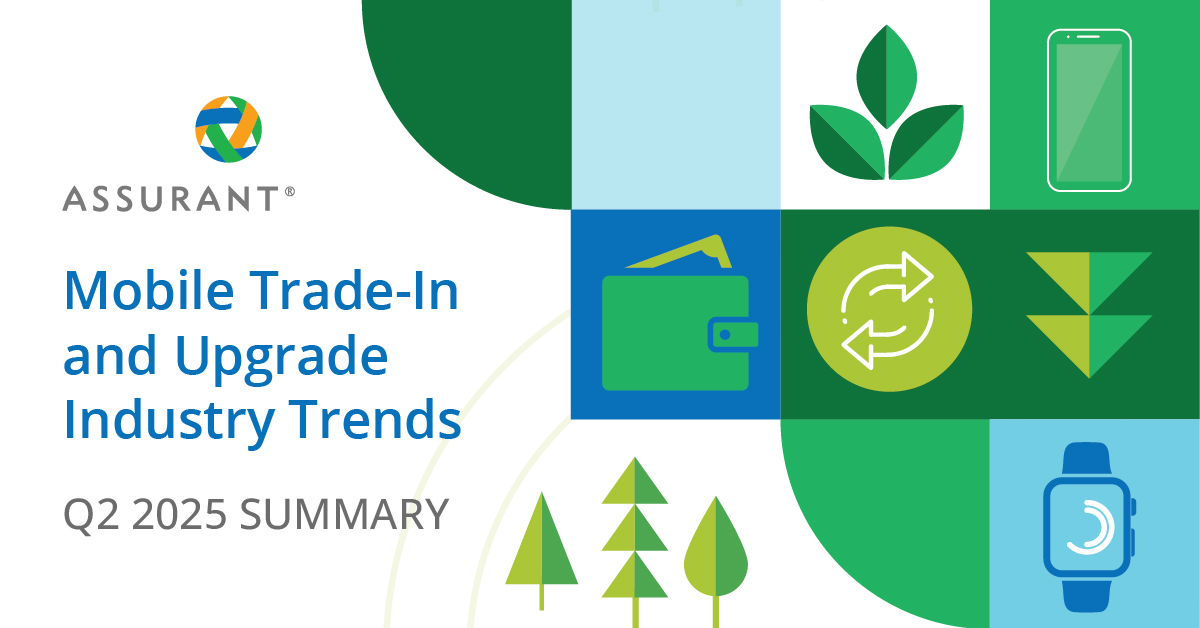In today's environmentally conscious marketplace, implementing effective circularity strategies isn't just good for the planet — it's good for business. By optimizing your mobile device programs for sustainability, you can create valuable secondary market opportunities while meeting the growing consumer demand for eco-friendly practices.
What is Device Circularity?
Device circularity focuses on maximizing the lifecycle of mobile devices through reuse, refurbishment, and repair. It reduces waste and minimizes the environmental impact of manufacturing new products. By prioritizing circularity, businesses save resources, cut costs, and generate revenue by reintroducing devices into the secondary market.
Here are ten proven strategies to enhance sustainability in your mobile device ecosystem while generating new revenue streams.
1. Enable Seamless Integration of Trade-In at Point of Sale
Make trade-in options simple and noticeable throughout the shopping experience, whether customers are buying online or in stores.
Online, include clear trade-in prompts during checkout to make it easy for shoppers to opt in, like, “Have an old device to trade in?” with easy-to-follow instructions. In physical stores, use eye-catching signage near the checkout area or display counters to remind customers about trade-in opportunities.
Train sales staff to actively mention trade-ins during customer interactions. For example, when a customer is looking at a new device, staff can ask, “Are you thinking about upgrading? Don’t forget we can give you money for your old phone!” This way, trade-ins become an integral part of the conversation rather than an afterthought.
When trade-ins are seamlessly integrated like this, more consumers participate, and fewer devices end up as e-waste. Instead, those used devices can be refurbished and resold in secondary markets. Refurbished devices support sustainability and provide affordable options for customers. It’s a win-win for your business and the planet.
2. Promote Upgrade Programs
Early upgrade programs create a steady flow of quality used devices by encouraging customers to upgrade sooner, typically within two years. This shorter cycle provides businesses with newer models that hold more value in the secondary market, appealing to buyers with the latest features and technology.
For customers, these programs offer convenience and flexibility, making it easier to access the latest devices without long waits or high costs.
3. Monitor Program Effectiveness
Regularly evaluate and update trade-in offers to ensure they remain competitive within the industry.
By analyzing trends and competitor offerings, you can adjust trade-in values and promotions to maximize participation. Limited-time deals tied to new product launches or seasonal sales can encourage engagement, while focusing on collecting high-demand devices boosts the value of your program. These efforts build customer trust, strengthen loyalty, and provide a steady supply of quality devices for refurbishment and resale.
For customers, competitive trade-in programs offer meaningful value, making it easier and more appealing to upgrade devices. Programs that reflect market needs help customers feel confident they’re getting the best deal while also promoting sustainability by reducing e-waste. Businesses benefit from adapting their offers to align with both customer expectations and environmental goals, ensuring long-term success and continued growth.

4. Expand Trade-In Categories
Look beyond smartphones and include wearables, hearables, and tablets in your trade-in programs.
By going beyond traditional smartphone trade-ins, you’ll cater to a broader audience with diverse technology needs. Customers who own smartwatches, wireless earphones, and tablets get the added convenience of trading in these devices, making the program more appealing and inclusive. This fosters customer satisfaction and loyalty and encourages repeat participation across a variety of products.
For businesses, this approach enhances inventory diversity in secondary markets, allowing you to meet the growing demand for pre-owned devices like fitness trackers, hearables, and tablets. This diversity drives revenue and enables a stronger competitive edge.
From a sustainability perspective, accepting more device types amplifies your impact by reducing the number of electronics discarded as e-waste. By refurbishing or properly recycling these items, you’re promoting a circular economy while attracting environmentally conscious consumers who value brands committed to green initiatives.
5. Encourage Repair and Reuse
Device protection plans and repair services significantly extend product lifespans, offering value to both customers and businesses. Affordable repair options and protection plans covering accidental damage enable customers to maintain their devices rather than replace them, saving money and boosting peace of mind. These services build trust, promote long-term loyalty, and encourage customers to stay engaged with your brand.
For businesses, they create additional revenue while preserving the value of devices for future trade-ins. Encouraging repairs supports sustainability by reducing e-waste and appeals to eco- conscious consumers. By incorporating these offerings, businesses not only strengthen customer relationships but also advance their commitment to environmentally responsible practices.
Advancing Sustainability: Embracing the Circular Economy in the Mobile Device Industry
E-waste is a significant issue, with over 60 million metric tons discarded in 2024. Our eBook discusses initiatives for the mobile device industry to support a circular economy, reducing environmental impact and extending device lifecycles.
6. Highlight Sustainability
Consumers today value sustainability, often factoring environmental impact into their buying choices. Highlight the benefits of your take-back programs with strategic marketing, like social media campaigns and digital ads that showcase how refurbished devices get a second life or how much e-waste your efforts save from landfills. Use in-store messaging, events, and eco- friendly branding to reinforce your commitment to sustainability.
Transparency builds trust with eco-conscious shoppers. Share clear metrics, such as the number of recycled devices or the reduction in carbon emissions. Open reporting and authentic messaging help position your brand as a leader in sustainability, attracting environmentally aware customers and setting you apart in a competitive market. This approach not only supports the planet but fosters brand loyalty and long-term growth.
7. Offer Certified Pre-Owned Devices
Refurbished pre-owned devices, tested and certified for quality, offer a unique way for businesses to drive revenue while supporting sustainability goals. These devices provide budget- conscious consumers with reliable, affordable alternatives to new products, making premium technology more accessible.
By reducing the need for new device production, refurbished devices cut down on resource use, energy consumption, and carbon emissions. This promotes a circular economy, where products are reused instead of discarded, decreasing e-waste. Businesses benefit by broadening their customer base and appealing to eco-conscious buyers, solidifying their reputation as environmentally responsible and innovative market leaders.
8. Leverage Warranty and Device Fulfillment
Integrating pre-owned devices into warranty and protection programs offers a cost-effective and sustainable solution. Refurbished devices lower warranty expenses by replacing faulty products at a reduced cost, freeing resources for other investments. Environmentally, they cut demand for resource-heavy manufacturing and extend the lifecycle of devices, reducing e-waste and greenhouse gas emissions.
For eco-conscious consumers, this practice highlights your commitment to sustainability, enhancing your brand’s image as socially and environmentally responsible. By adopting pre- owned devices, you benefit businesses, customers, and the planet while fostering loyalty and growth in a competitive market.
9. Achieve Net Zero Carbon Emissions
Tools like Assurant Carbon IQ℠ provide businesses with critical insights into emissions across their mobile programs, enabling data-driven decisions to meet sustainability goals. By analyzing device lifecycle carbon footprints, companies can identify areas for optimization, such as supply chain improvements or extended device lifecycles. These actions reduce emissions, enhance efficiency, and align with environmental targets.
Using these tools demonstrates a commitment to transparency and sustainability, building trust with consumers and appeal among eco-conscious investors. Sharing measurable progress helps businesses stand out, showing leadership in reducing environmental impact while fostering growth and loyalty.
10. Engage With Industry Organizations
Collaborating with organizations like the GSMA and Consumer Technology Association® strengthens your sustainability initiatives by aligning them with proven industry best practices. These partnerships help refine your programs, making them more effective while contributing to larger environmental goals. By engaging with these groups, you gain access to emerging trends and technologies, from innovations in energy efficiency to strategies for reducing e- waste.
Participation fosters innovation within your business, inspiring new ideas and positioning you as a leader in sustainability. This proactive approach not only enhances your credibility with consumers and investors but also ensures your efforts remain impactful and future-focused.
By implementing these strategies, you can create a cycle of sustainability that benefits your business, your customers, and the planet. Circularity isn't just an environmental imperative — it’s a business opportunity that transforms pre-owned devices into valuable assets for the secondary market.
Want to learn more about advancing sustainability within the mobile industry?
Download our latest ebook for in-depth insights and implementation strategies.






